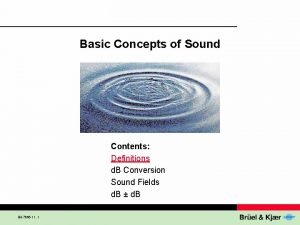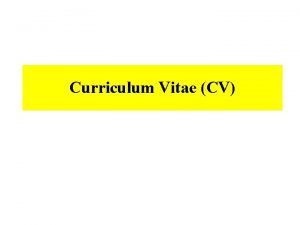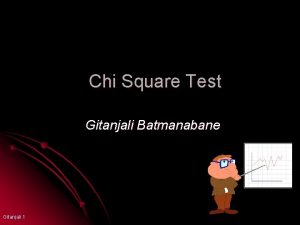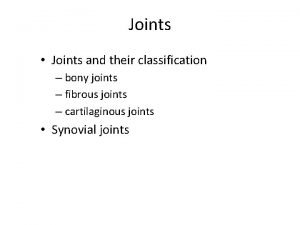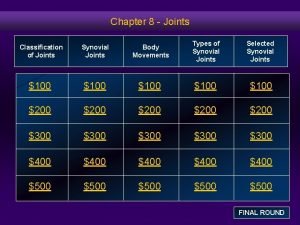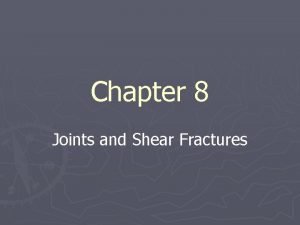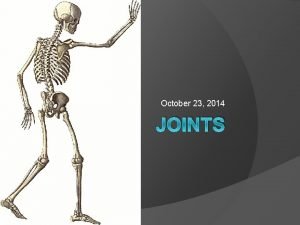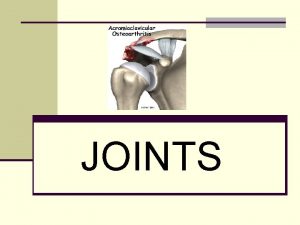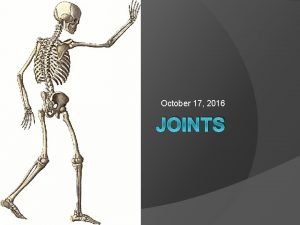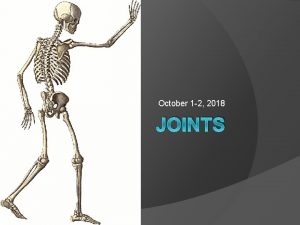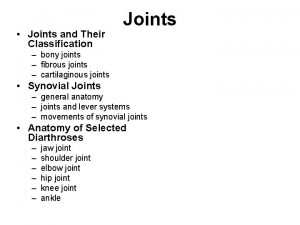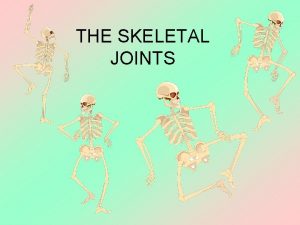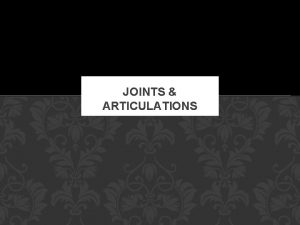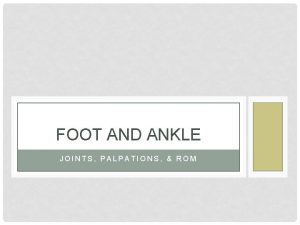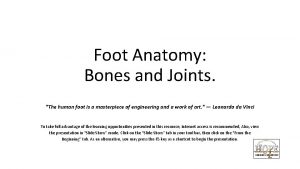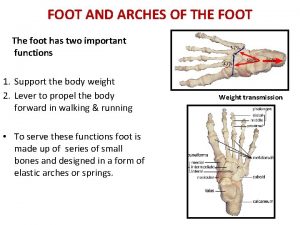Joints of the Foot Dr Gitanjali Khorwal Contents























































- Slides: 55

Joints of the Foot Dr. Gitanjali Khorwal

Contents of the anterior compartment o Muscles: 1. Tibialis anterior 2. Extensor digitorum longus 3. Extensor hallucis longus 4. Peroneus tertius o Anterior tibial artery o Deep peroneal nerve.

Muscles of the anterior compartment

Retinacula Deep fascia is thickened to form bands. Retain tendons in place. • Superior Extensor Retinaculum • Inferior Extensor Retinaculum • Superior Peroneal Retinaculum • Inferior Peroneal Retinaculum

Muscles of the back


Muscles of lateral side

ANKLE or TALO-CRURAL JOINT Uni-axial synovial joint Modified hinge joint

Tibio-fibular mortise

Trochlea tali

Ligaments §Capsule §Synovial membrane §The ankle joint is bound medially by the strong Deltoid ligament § Three lateral ligaments • Anterior talofibular ligament • Posterior talofibular ligament • Calcaneofibular ligament


Deltoid ligament or Medial ligament Superficial part: Anterior part or Tibio - navicular part Intermediate part or Tibio - calcanean part • Posterior part or Posterior tibio - talar part • • Deep part/Anterior Tibiotalar


Attachments & parts of deltoid ligament Anterior Tibiotalar Medial malleolus of Tibia Tibiotalar Talus Tibionavicular Tibiocalcanean Sustanticulum Tali


Lateral ligaments Anterior Talofibular Lateral malleolus of Fibula Posterior Talofibular Neck of Talus Calcaneofibular ligament crossed by tendons of Peroneus longus & Brevis

Movements of ankle joint Dorsiflexion: Close packed state. Position more stable. Plantar flexion: Loosely packed state of joint. Joint is less stable.


Movements Plantar Flexion: S 1, S 2 Gastrocnemius Soleus Assisted by Tibialis posterior, Flexor Digitorum longus, Flexor Hallucis longus, Peroneus longus and brevis in extreme plantar flexion

Dorsiflexion: L 4, L 5 Tibialis anterior Extensor Digitorum longus, Extensor Hallucis longus, Peroneus tertius




Arterial supply • Malleolar branches of Anterior Tibial Artery. • Malleolar branches of Peroneal Artery. NERVE SUPPLY • • Branches from Deep Peroneal Nerve. Branches from Tibial Nerve.

Interphalangeal joints Typical hinge joint Permit plantar flexion and dorsiflexion

Metatarso - phalangeal joints Ellipsoidal type of synovial joint. Ligaments: • • • Capsule. Collateral ligaments. Deep metatarsal ligaments. Movements: • • Dorsi & plantar flexion. Adduction & abduction.

Tarso-metatarsal joints Plane synovial joints Gliding movements

Intertarsal joints SIX synovial cavities between tarsus and metatarsus : a) Sub-talar b) Talo-calcano-navicular Mid-tarsal / Transverse c) Calcaneo-cuboid tarsal d) A joint cavity comprising cuneo -navicular, intercuneiform, cuneo-cuboid and intermediate and lateral cuneiform with bases of 2 nd and 3 rd metatarsal bone. e) Between medial cuneiform and base of 1 st metarcarpal. f) Between cuboid and 4 th and 5 th metacarpal

SUBTALAR JOINT /Posterior talo-calcanean joint Ligaments Capsule Medial and lateral talo-calcanean ligaments Interosseous talo-calcaneanligament Cervical ligament

Interosseous talo-calcanean ligament Cervical ligament

Midtarsal or transverse tarsal joints TRANSVERSE TARSAL JOINT (MIDTARSAL JOINT) CALCANEO-CUBOID JOINT TALONAVICULAR JOINT

Midtarsal or transverse tarsal joint • Talonavicular joint • Calcaneocuboid joint Medial view of foot

Talo-calcaneo-navicular joint Restricted ball and socket type of joint Ligaments Talo-navicular ligament Plantar calcaneo-navicular Calcaneo-navicular part of bifurcated ligaments

The bifurcated ligament Y-shaped band. Its stem attached proximally to the anterior part of the upper calcaneal surface Distally it divides into 2 limbs - calcaneocuboid and calcaneonavicular parts. The calcaneocuboid ligament extends to the dorsomedial aspect of the cuboid The calcaneonavicular ligament is attached to the dorsolateral aspect of the navicular

Midtarsal or transverse tarsal joints • Talonavicular joint • Calcaneocuboid joint Lateral view of foot

CALCANEOCUBOID JOINT Saddle or sellar joint. Between anterior surface of calcaneus & posterior surface of cuboid CALCANEOCUBOID JOINT

Ligaments • Capsule • Calcaneocuboid part of bifurcate ligament • Long plantar ligament • Short plantar or Plantar calcaneocuboid ligament

BIFURCATE LIGAMENT DORSAL CALCANEOCUBOID LIGAMENT CALCANEOCUBOID JOINT

SHORT PLANTAR LIGAMENT (Plantar calcaneocuboid ligament) LONG PLANTAR LIGAMENT PLANTAR VIEW

Lateral Medial • The longest ligament associated with the tarsus. • From Plantar surface of the calcaneus to plantar surface of the cuboid • The deep fibres are attached to the cuboid and more superficial fibres to the bases of the 2 nd, 3 rd and 4 th and sometimes fifth, metatarsals. Long plantar ligament

Plantar calcaneocuboid ligament • Is deeper than the long plantar ligament • From the anterior calcaneal tubercle to the cuboid

Movements INVERSION EVERSION

Inversion & Eversion These movements are essential to adjust the foot while walking on uneven surface.

Inversion Sole is directed downwards & medially. Associated with plantar flexion

Eversion Sole is directed downwards & laterally. Associated with dorsiflexion

Joints on which it occurs Lateral view • Subtalar joint • Transverse tarsal joint. • Talo-calcaneo-navicular joint Medial view

Axis of movement Passes obliquely upwards, forward & medially from the heel end of calcaneus through sinus tarsi to dorso-medial surface of neck of Talus

Muscles causing Inversion Tibialis Anterior Tibialis Posterior

Muscles causing Eversion Peroneus longus Peroneus brevis Peroneus tertius

EVERSION LIMITED BY DELTOID LIGAMENT TIBIALIS ANTERIOR TIBIALIS POSTERIOR Medial view of the skeleton of foot

INVERSION LIMITED BY LATERAL TALOCALCANEAL LIGAMENT CERVICAL LIGAMENT CALCANEOFIBULAR LIGAMENT PERONEUS BREVIS PERONEUS LONGUS Lateral view of the skeleton of foot

APPLIED ANATOMY Ankle sprains : Lateral Ankle Sprains caused by Over inversion of foot, which is common causes anterior talofibular & calcaneo - fibular ligaments to tear. a/k/a Low Ankle sprain Medial Ankle Sprains When foot is forcibly everted fibres of deltoid ligament are torn.


 Hypotenuse formula for right triangle
Hypotenuse formula for right triangle You put your right foot in you put your right foot out
You put your right foot in you put your right foot out Thiếu nhi thế giới liên hoan
Thiếu nhi thế giới liên hoan Tia chieu sa te
Tia chieu sa te Chúa yêu trần thế alleluia
Chúa yêu trần thế alleluia điện thế nghỉ
điện thế nghỉ Một số thể thơ truyền thống
Một số thể thơ truyền thống Hệ hô hấp
Hệ hô hấp Công thức tính thế năng
Công thức tính thế năng Thế nào là số nguyên tố
Thế nào là số nguyên tố Tỉ lệ cơ thể trẻ em
Tỉ lệ cơ thể trẻ em đặc điểm cơ thể của người tối cổ
đặc điểm cơ thể của người tối cổ Các châu lục và đại dương trên thế giới
Các châu lục và đại dương trên thế giới ưu thế lai là gì
ưu thế lai là gì Thẻ vin
Thẻ vin Môn thể thao bắt đầu bằng từ chạy
Môn thể thao bắt đầu bằng từ chạy Tư thế ngồi viết
Tư thế ngồi viết Cái miệng xinh xinh thế chỉ nói điều hay thôi
Cái miệng xinh xinh thế chỉ nói điều hay thôi Hát kết hợp bộ gõ cơ thể
Hát kết hợp bộ gõ cơ thể Từ ngữ thể hiện lòng nhân hậu
Từ ngữ thể hiện lòng nhân hậu Trời xanh đây là của chúng ta thể thơ
Trời xanh đây là của chúng ta thể thơ Tư thế ngồi viết
Tư thế ngồi viết V. c c
V. c c Chó sói
Chó sói Thơ thất ngôn tứ tuyệt đường luật
Thơ thất ngôn tứ tuyệt đường luật Sự nuôi và dạy con của hươu
Sự nuôi và dạy con của hươu Diễn thế sinh thái là
Diễn thế sinh thái là đại từ thay thế
đại từ thay thế Thế nào là hệ số cao nhất
Thế nào là hệ số cao nhất Frameset trong html5
Frameset trong html5 Vẽ hình chiếu vuông góc của vật thể sau
Vẽ hình chiếu vuông góc của vật thể sau Phép trừ bù
Phép trừ bù Thế nào là mạng điện lắp đặt kiểu nổi
Thế nào là mạng điện lắp đặt kiểu nổi Cách giải mật thư tọa độ
Cách giải mật thư tọa độ Lời thề hippocrates
Lời thề hippocrates Vẽ hình chiếu đứng bằng cạnh của vật thể
Vẽ hình chiếu đứng bằng cạnh của vật thể Glasgow thang điểm
Glasgow thang điểm Quá trình desamine hóa có thể tạo ra
Quá trình desamine hóa có thể tạo ra Sự nuôi và dạy con của hổ
Sự nuôi và dạy con của hổ Các châu lục và đại dương trên thế giới
Các châu lục và đại dương trên thế giới Dạng đột biến một nhiễm là
Dạng đột biến một nhiễm là Bổ thể
Bổ thể Nguyên nhân của sự mỏi cơ sinh 8
Nguyên nhân của sự mỏi cơ sinh 8 độ dài liên kết
độ dài liên kết How to develop a crm strategy
How to develop a crm strategy Febrile non hemolytic transfusion reaction
Febrile non hemolytic transfusion reaction What is a marketing plan
What is a marketing plan Content page magazine
Content page magazine When organizing your career portfolio you should
When organizing your career portfolio you should Science table of contents
Science table of contents Dlginit
Dlginit Sound contents
Sound contents Curriculum vitaem
Curriculum vitaem All the following accurately describe hadoop except
All the following accurately describe hadoop except Contents of a dead mans pocket
Contents of a dead mans pocket Beaded dentinal tubules
Beaded dentinal tubules



















































